archaeology of Sicily
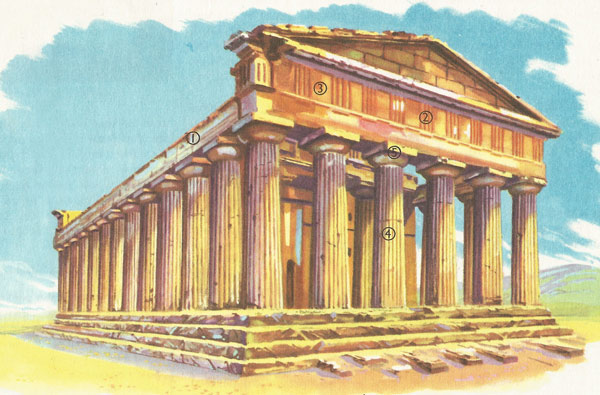
Figure 1. The Temple of Concordia at Acragas. 1. The architecture is smooth, and has no decoration. 2. These are the triglyphs; they imitate the beams of wood that supported the roofs of earlier temples built entirely of wood. 3. The spaces between the triglyphs are called metopes. In later periods they were decorated with sculpture. 4. The columns are tall, measuring 22 feet 5 inches. They are not perfectly cylindrical; they become narrower towards the top and have a slight curve. This curve and the tapering effect give harmony and elegance to the column. Every column has twenty flutes. These give the appearance of slenderness, and make the columns appear taller than it really is. Also the way in which the light falls on the flutes creates shadows that increase the effect of beauty. 5. The capitol if formed by the echinus, a sort of curved basin which looks as though it were being squashed beneath the weight of the slab which crowns it, and completes the capitol.
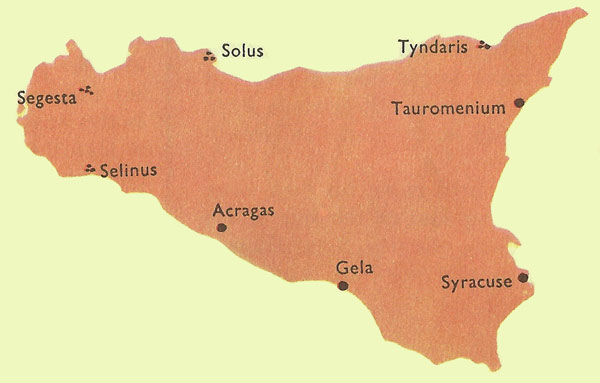
Figure 2. These are the principal sites on Siciliy famous for Greek and Roman remains. Some of them are cities that are important today; some are isolated places where the ruins have only been brought to light by the archaeologist's spade.
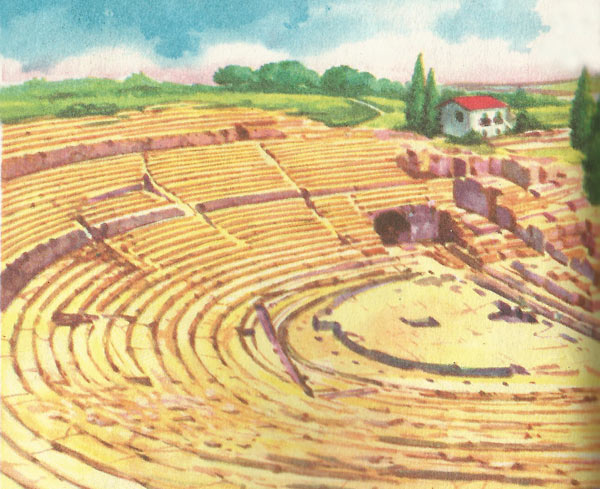
Figure 3. The Greek theater at Syracuse, one of the largest theaters of the ancient world.
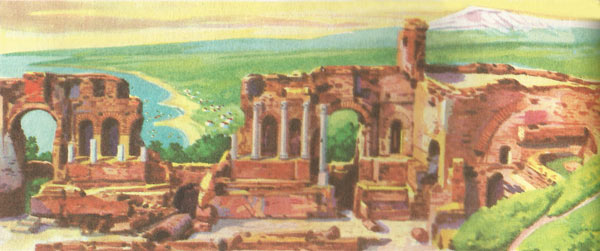
Figure 4. The acropolis of the ancient city of Tauromenium on the summit of Mt. Taurus.
Greek civilization was the first of the great ancient civilisations to leave a lasting mark on Sicily. From the 8th century BC onwards, settlers from various city-states of mainland Greece came to establish settlements (apoikiai), which, right from their foundation (unlike Roman and modern colonies) were independent of their 'Metropolis' or mother-city. Sometimes the Greeks conquered the native peoples they encountered, sometimes they made friends with them. Sicily in fact takes its name from one of these peoples, the Sicels; originally it had been called Trinacria, meaning 'land in the shape of a triangle'. Despite the ravages of time, Sicily is particularly rich in Greek archaeological remains, especially temples, fortresses and theatres. Many of these are of great beauty. There are also some remains dating from the Roman era; the Romans often restored and used Greek buildings (Figure 2).
Before considering the most important Greek monuments in Sicily one by one, let us have a general look at them and try to understand what makes them so beautiful.
Syracuse
Syracuse has a richer history than any other city in Sicily. It was founded by the Greeks in the 8th century BC, on the little island of Ortygia which is still the center of the modern city.
Syracuse was not only powerful; it was also for a long time second only to Athens as a center of learning and art. In ancient times the city was larger than it is today, and included several districts which no longer exist, Achradina, Tyche, Neapolis ('new city'), and Epipolae.
The present-day Cathedral is built on the site of the ancient temple of Athena, the columns of which can still be seen. This temple had doors of ivory and gold, and above them on the tympanum was the golden shield of the goddess Athena that could be seen from a long way out to sea and showed the way to sailors. The Greek theater is one of the largest of the ancient world: measuring 138 meters in diameter, it could seat several thousand people in its 61 rows.
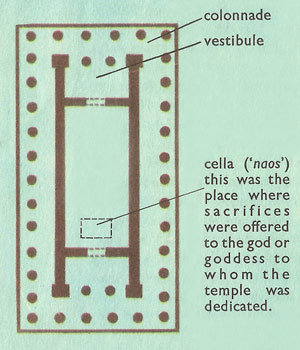 |
| Plan of a Greek temple
|
The fortress of Euryalus (the name means 'large-headed nail') is the finest and most complete military establishment of the Greek period in Sicily. It has an area of over 12,500 square meters, and was built in six years by Dionysius 1 for the defence of the city against the Carthaginians.
Tauromenium
Tauromenium was refounded as a Greek city in 358 BC by a Greek called Andromachus. It has an exceptionally beautiful situation between the sea and the impressive background of Mt. Etna. The ancient city had an acropolis (citadel for defence) on the summit of Mt. Taurus (Figure 4); in the former center are the ruins both of the small Roman theater and of the splendid Greek theater, cut out of the rock. This is the second largest Greek theater in Sicily: it is 109 meters in diameter at its widest point. The Greeks performed plays there; but when the Romans restored it they used it for gladiators.
Acragas
The city of Acragas was founded in 582 BC by people from Gela. At the height of its prosperity it was one of the most splendid cities of the ancient world, with a large population. It now possesses the ruins of several beautiful temples.
The Temple of Concordia (Figure 1) is one of the best preserved monuments at Acragas (the Roman Agrigentum). Built in the first half of the 5th century BC, it is in the style known as Doric, which is notable for its great simplicity and for the harmonious proportions of the various parts which make up the buildings, the columns, capitals and architraves. These essential parts also act as the only form of decoration.
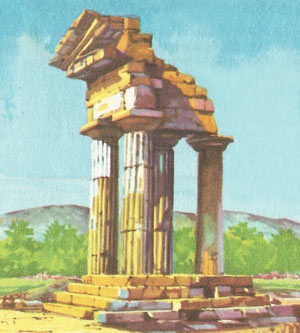 |
| Acragas: the ruins of the Temple of Castor and Pollux
|
Segesta
Segesta (also called Egesta), may have been founded as early as the 12th century BC: the Segestans believed their ancestors had come from Troy. There is still today a magnificent Doric temple in an excellent state of preservation. Nearby a theater with twenty rows of seats has been excavated.
Solus
This city was founded by the Phoenicians at the foot of Mt. Catalfano: the Greeks called it Solus, the Romans Soluntum. The most important building is the one known as the gymnasium, of which all that remains are six Doric columns supporting an architrave.
Tyndaris
The ruins of Tyndaris lie near the headland of that name. The city was founded by Dionysius 1 of Syracuse in 396 BC: like Segesta, it was eventually destroyed by the Saracens. The ancient walls with towers and a main gate can still be seen. Excavations begun in 1950 have revealed a basilica dating from Roman times and a Greek theater.
Gela
The founders of this city came here from Crete and Rhodes in 690 BC. There are important remains of Greek fortifications, probably built in the fifth century BC. Gela was the center of the Sicilian pottery industry, and its Greek vases can be seen in museums all over Europe.
Selinus
One of the most interesting and important places in Sicily from an archaeological point of view. The name is said to have come from the Greek word 'selinon', meaning 'wild celery' – a common plant in the neighbourhood. Selinus was a flourishing city in the 5th century BC when large temples were built; the great Doric temple of Zeus, 109 meters In length, is one of the largest of Greek temples.
